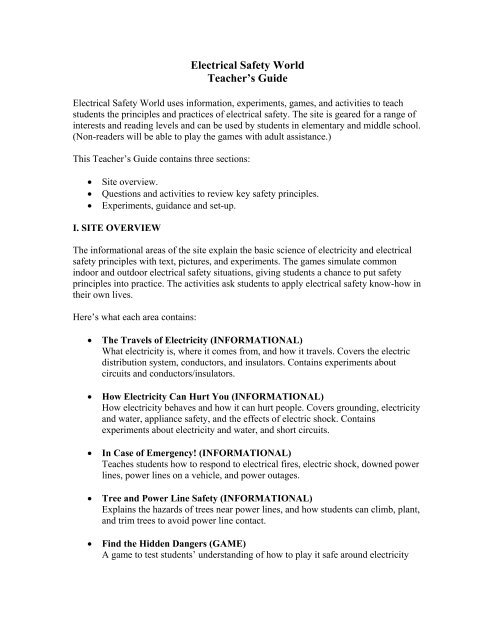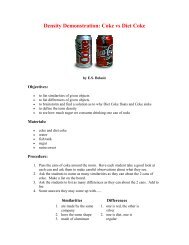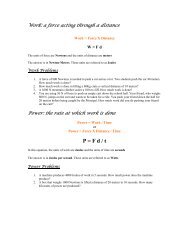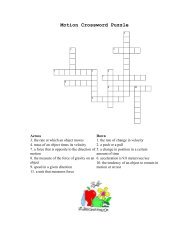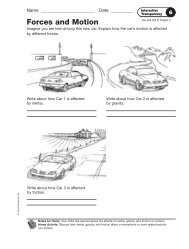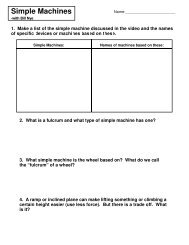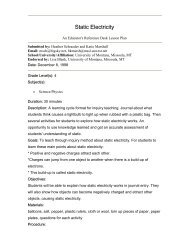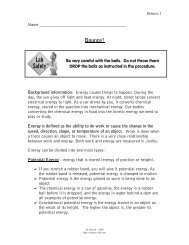5th and 6th Grade Teacher Guide
5th and 6th Grade Teacher Guide
5th and 6th Grade Teacher Guide
You also want an ePaper? Increase the reach of your titles
YUMPU automatically turns print PDFs into web optimized ePapers that Google loves.
Electrical Safety World<strong>Teacher</strong>’s <strong>Guide</strong>Electrical Safety World uses information, experiments, games, <strong>and</strong> activities to teachstudents the principles <strong>and</strong> practices of electrical safety. The site is geared for a range ofinterests <strong>and</strong> reading levels <strong>and</strong> can be used by students in elementary <strong>and</strong> middle school.(Non-readers will be able to play the games with adult assistance.)This <strong>Teacher</strong>’s <strong>Guide</strong> contains three sections:• Site overview.• Questions <strong>and</strong> activities to review key safety principles.• Experiments, guidance <strong>and</strong> set-up.I. SITE OVERVIEWThe informational areas of the site explain the basic science of electricity <strong>and</strong> electricalsafety principles with text, pictures, <strong>and</strong> experiments. The games simulate commonindoor <strong>and</strong> outdoor electrical safety situations, giving students a chance to put safetyprinciples into practice. The activities ask students to apply electrical safety know-how intheir own lives.Here’s what each area contains:• The Travels of Electricity (INFORMATIONAL)What electricity is, where it comes from, <strong>and</strong> how it travels. Covers the electricdistribution system, conductors, <strong>and</strong> insulators. Contains experiments aboutcircuits <strong>and</strong> conductors/insulators.• How Electricity Can Hurt You (INFORMATIONAL)How electricity behaves <strong>and</strong> how it can hurt people. Covers grounding, electricity<strong>and</strong> water, appliance safety, <strong>and</strong> the effects of electric shock. Containsexperiments about electricity <strong>and</strong> water, <strong>and</strong> short circuits.• In Case of Emergency! (INFORMATIONAL)Teaches students how to respond to electrical fires, electric shock, downed powerlines, power lines on a vehicle, <strong>and</strong> power outages.• Tree <strong>and</strong> Power Line Safety (INFORMATIONAL)Explains the hazards of trees near power lines, <strong>and</strong> how students can climb, plant,<strong>and</strong> trim trees to avoid power line contact.• Find the Hidden Dangers (GAME)A game to test students’ underst<strong>and</strong>ing of how to play it safe around electricity
outdoors. Within busy street scenes, students must identify electrical hazardsinvolving power lines <strong>and</strong> electrical equipment.• Make the Safe Choice (GAME)A game to test students’ awareness about electrical safety inside the home. Thegame presents electrical hazards that are relevant to students’ lives <strong>and</strong> asksstudents to identify the safest response.• Shock Blocker (GAME)Students play against the computer to prevent water from creating a path forelectricity to flow from a power line, electrical outlet, or lightning bolt.• Tell Me More About Electricity (INFORMATIONAL)This section is not safety-related but instead provides additional information forstudents interested in other aspects of electricity. Covers electricity basics,electricity generation, pioneers of electrical discovery, electric vehicles, <strong>and</strong>energy efficiency/conservation.• Home Safety Audit (ACTIVITY)A checklist students can use with parents to inspect their home for electricalhazards.• Tell Your Story (ACTIVITY)Profiles a real-life shock victim who is an Olympic kayaker. Asks students tointerview someone who has had an electric shock, to tell their own electric shockstory, or to report on one from a newspaper article. Focus is on sharing how theincident occurred <strong>and</strong> how it could have been prevented.• Safety CertificateThis is a checklist of site locations students can use to map their progress, plus anelectrical safety pledge. We recommend students print the certificate beforestarting the site <strong>and</strong> have a parent or other adult sign it after they have visited themain areas.• GlossaryDefinitions of electricity-related words found on the site. These definitions maybe accessed by clicking on the words wherever they appear highlighted on the site(usually their first reference within a section.)• Links to Related SitesHot links to related sites about the science of electricity, electrical inventions, <strong>and</strong>electrical safety.
II. QUESTIONS AND ACTIVITIESThese questions <strong>and</strong> activities review the key safety principles from Electrical SafetyWorld. Here are a few ideas for how to use them with your class:• Use as discussion points for verbally reviewing basic electrical safety informationwith the whole group.• Use as a pre- <strong>and</strong> post-test to assess student underst<strong>and</strong>ing of electrical safetyprinciples before <strong>and</strong> after visiting Electrical Safety World. (To use as a writtentest for older students, cut <strong>and</strong> paste the questions into your word processingprogram, delete the answers, <strong>and</strong> print out one sheet for each student.)• Put students into small groups <strong>and</strong> assign each group several questions; ask themto use the website to find the answers. (Answers to questions 1-12 can be found inThe Travels of Electricity; questions 13-19 are based on How Electricity Can HurtYou.)• After all students have completed all sections of the website, organize the classlike a game show: “contestants” can continue to answer questions until they getone incorrect, at which point a new contestant takes their place.Electrical Safety Questions1. What is electricity a form of? (Energy.)2. What does electricity travel on to get from the power plant to people’s houses?(Overhead <strong>and</strong> underground power lines.)3. What other equipment is involved in getting electricity to where it can be used bypeople? (Some or all of the following are correct: substations, pole-mounted <strong>and</strong> padmountedtransformers, service drops, meter boxes, electrical wiring, appliance cords.)4. How fast does electricity travel? (At the speed of light, 186,000 miles per second.)5. Could you move faster than electricity? (No!)6. List some good conductors of electricity. (Metal, water)7. Is the human body a good conductor of electricity? Why/why not? (Yes, because it ismostly water.)8. What will happen if electricity travels through you? (You will be shocked <strong>and</strong> could bebadly hurt or even killed.)9. List some good insulators. (Special rubber, glass.)10. Why are insulators important? (They keep electricity from leaving wires.)
11. What would happen if a power line were to fall from the power pole to the ground?(It would energize the area around it with a lot of electricity <strong>and</strong> people touching the lineor coming near it would be hurt or killed.)12. If you overload an outlet by plugging in too many things, what can happen? (Cordinsulation can overheat <strong>and</strong> melt, causing a shock <strong>and</strong> fire hazard.)13. Why are people good conductors of electricity? (Our bodies are mostly water, <strong>and</strong>water conducts electricity.)14. Do you have to be touching the ground directly to conduct electricity? (No, you couldbe touching something that is touching the ground, like a ladder.)15. Why should you never touch anything electrical while you have wet h<strong>and</strong>s or whilest<strong>and</strong>ing in water? (Water conducts electricity <strong>and</strong> you could be shocked.)16. What is the purpose of rubber or plastic insulation around appliance cords? (It keepsthe electricity in the wires <strong>and</strong> prevents you from getting a shock.)17. If a person is shocked, what can happen? (Muscle spasms, weakness, rapid pulse,severe burns, unconsciousness, or death.)18. Why can birds sit on power lines without being shocked? (The birds do not touch theground or anything in contact with the ground.)19. Why could a kite caught in a power line be dangerous to try to retrieve? (If you touchthe kite while you are in contact with the ground or anything touching the ground, like aladder, electricity will travel from the power lines down the kite <strong>and</strong> into you, <strong>and</strong> youwill be shocked.)Activities for Going Further• Prepare a one-minute presentation or play for your class on the basics of howelectricity travels from the power plant to appliances in people’s homes.• Prepare a poster showing electricity going through a person on its way to theground. The source of the electricity could be a power line or an appliance cord.• Think of three ways you can convince your friends to be safe around electricity.Share them with the class.• Create a radio commercial about outdoor or indoor electrical safety.• Write an essay describing electrical hazards found in an imaginary house.
III. EXPERIMENTSComplete a CircuitMaterials:Students will need the materials listed (1 D-cell battery, 1 1.2-volt lightbulb, 1 E-10lightbulb base, two 12-inch pieces of insulated solid str<strong>and</strong> 18-22 gauge copper wire withone inch of insulation removed at each end, masking tape). Bulbs, bases, <strong>and</strong> wire can bepurchased at stores like Radio Shack. Make sure the lightbulbs <strong>and</strong> bases match.Safety First:• Students should be supervised by an adult while doing this experiment.• A teacher or another adult should be responsible for stripping insulation fromwires.• Explain to students that electricity can be dangerous if it is not h<strong>and</strong>led correctly,<strong>and</strong> emphasize they should never experiment with the electricity that comes froma wall outlet. It’s much more powerful than the electricity made by small batteries<strong>and</strong> could seriously injure or even kill someone.Objective:Students will build a circuit <strong>and</strong> equate it to the path of electricity that comes from powerplants.Getting It Across:1. Have students read the information <strong>and</strong> follow the steps on the page.2. Make sure they are able to identify the circuit electricity travels from the batteryto the lightbulb <strong>and</strong> back, <strong>and</strong> the circuit electricity travels from power plants tohomes <strong>and</strong> back. They should be able to equate the wires in the experiment withpower lines <strong>and</strong> electrical wiring in the electric distribution system.Questions <strong>and</strong> Answers:• What part of the distribution system is like the wires in the experiment? (Powerlines <strong>and</strong> electrical wiring.) What happens if you only tape one of the wires to thebattery? Why? (The bulb does not light. The circuit is not complete unless bothwires are taped to the battery, allowing electricity to flow in a circle.)
Experiment with Conductors <strong>and</strong> InsulatorsMaterials:Students will need 1 D-cell battery, 1 1.2-volt lightbulb, 1 matching lightbulb base, one12-inch piece <strong>and</strong> two 4-inch pieces of insulated solid str<strong>and</strong> 18-22 gauge copper wirewith one inch of insulation removed at each end, <strong>and</strong> masking tape. Bulbs, bases, <strong>and</strong>wire can be purchased at stores like Radio Shack. Make sure the lightbulbs <strong>and</strong> basesmatch. Students will also need a variety of things they think might conduct electricity,such as toothpicks, rubber b<strong>and</strong>s, paper clips, plastic, fruit, etc.Safety First:• Students should be supervised by an adult while doing this experiment.• A teacher or another adult should be responsible for stripping insulation fromwires.• Explain to students that electricity can be dangerous if it is not h<strong>and</strong>led correctly,<strong>and</strong> emphasize they should never experiment with the electricity that comes froma wall outlet. It’s much more powerful than the electricity made by small batteries<strong>and</strong> could seriously injure or even kill someone.Experiment Tips:• <strong>Teacher</strong>s should strip the wires ahead of time <strong>and</strong> make sure the batteries arefresh. Though the illustration does not show it, use tape to stick the wires to theends of the battery.• Students are likely to know that metals are good conductors, but they may beunaware that things with a lot of liquids in them also conduct well. Some things tohave on h<strong>and</strong> include lemons, pickles, <strong>and</strong> potatoes. When testing these, makesure students stick wires into the wet part of the item.• The key in the conduction of electricity is the movement of electrons. Metals areelements that freely share electrons. In liquids, dissolved ions can carry a chargeas well. That is why water helps in the conduction of electricity. Salty water,loaded with sodium <strong>and</strong> chloride ions, helps even more.Objective:Students will learn the difference between conductors <strong>and</strong> insulators.Getting it Across:1. Have students bring in things they think might conduct electricity.2. Have teams read the information <strong>and</strong> follow the steps on the page.3. Students should first test their circuit by connecting it without any trial material.Questions <strong>and</strong> Answers:• Ask teams to share their predictions <strong>and</strong> results. Were the results the same? If not,why not? (Answers will vary. Be sure the experimental setup was not at fault.)• What conclusions can students draw about conductors <strong>and</strong> insulators? (Answerswill vary. Students might generalize that metals are good conductors or plastic is agood insulator.)
Electricity <strong>and</strong> WaterMaterials:Students will need the circuits they made for the “Conductors <strong>and</strong> Insulators” experiment,plus a glass pint or quart jar, 2 nails, 2 alligator clips, salt, <strong>and</strong> water.Safety First:• Students should be supervised by an adult while doing this experiment.• A teacher or another adult should be responsible for stripping insulation fromwires.• Explain to students that anything can conduct electricity when wet. Remindstudents that they can mix water <strong>and</strong> electricity safely in this experiment becausethe voltage is so minimal (1.5 V per D-cell battery).Objective:Students will demonstrate that water is a conductor of electricity.Getting it Across:Be sure students add plenty of salt to the water. Then have them predict, experiment, <strong>and</strong>note their observations. Share results.Questions <strong>and</strong> Answers:1. Ask students why they think the salt is needed. (Students will need to add a lot ofsalt to their water in order for electric current to flow. The voltage of the battery isso low that additional particles must be added to make the water MOREconductive. It is the impurities in water that make it a good conductor. Pure waterwill not conduct electricity. However, pure water is only found in the laboratory.That’s why there is so much emphasis on the conductivity of water as regardselectrical safety.)
Ben Franklin Was Lucky!Materials:Students will need the circuits they made for the “Complete a Circuit” experiment,modified as shown in the illustration (strip a 1-inch section of insulation off the middle ofeach wire). Students will also need a 6-inch piece of thicker wire with one inch ofinsulation removed at each end.Safety First:• Students should be supervised by an adult while doing this experiment.• A teacher or another adult should be responsible for stripping insulation fromwires.• Remind students that they are able to work with these batteries <strong>and</strong> wires becausethe voltage is minimal (1.5 V per D-cell battery). They should never experimentwith the electricity that comes from a wall outlet. It’s much more powerful thanthe electricity made by small batteries <strong>and</strong> could seriously injure or even killsomeone.Objective:Students will be able to describe a short circuit <strong>and</strong> compare it to the story about BenFranklin.Getting it Across:1. Have students read the information <strong>and</strong> follow the steps on the page.2. Be sure students underst<strong>and</strong> that they should immediately disconnect the thick wire<strong>and</strong> the battery after they observe what happens. The wires will get hot. This is a clueto why Franklin got shocked.Questions <strong>and</strong> Answers:• Students’ predictions <strong>and</strong> results will vary.• Why is this called a “short circuit”? (Because the electricity travels a shorter routethan the intended circuit. Electricity is not able to complete its intended path becausethe circuit is grounded somewhere.)• Why did Ben Franklin get shocked? (His arms functioned like the thick wire in theexperiment. Electricity traveled through his body instead of through the circuit, <strong>and</strong>he got shocked.)


